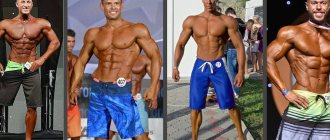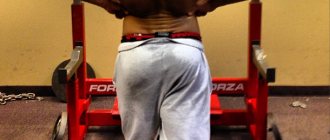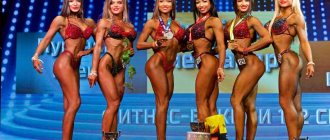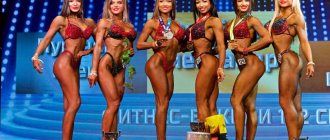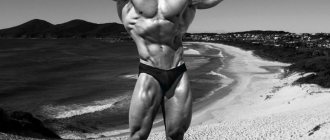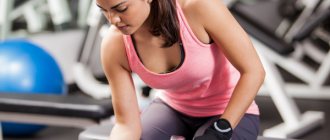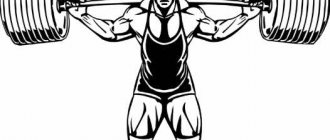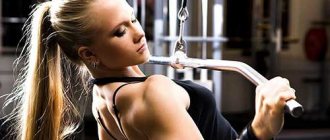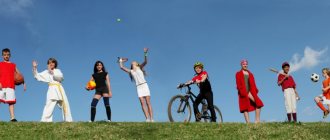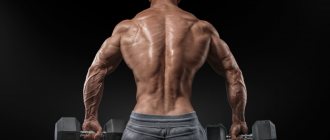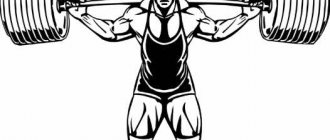Mens Physicist is a men's category in competitive bodybuilding for athletes with chiseled figures without a mountain of muscles. Here the priority is:
- symmetry;
- proportionality of forms;
- aesthetics.
The judges evaluate the width of the shoulders and torso, the shape of the deltas, the circumference of the waist, and the development of the abs. Due to the guys appearing on stage in shorts, this type was called “beach bodybuilding.”
Beach fitness for men is a new category created by the IFBB in 2012. The story began a year earlier. In Las Vegas, the organizers of Olympia invited athletes with beautiful relief to the casting for filming. 10 bodybuilders took part in posing, although there were many more willing to participate. The idea of the show was for guys to go on stage wearing shorts 2 cm above the knees and show off their naked torsos. The first champion of Men's Physic was Steve Cook, with whom one of the fashionable sports magazines immediately signed a long-term contract. Since then, the discipline has been separated into a separate category and since 2013 it has been introduced into the Olympia program . In Russia, this direction became popular in 2014.
A variety of categories Mens Physicist.
The variety of IFBB categories and their presence in the rating scale depend on the number of applicants who want to take part in the competition. Today there are the following categories:
- Juniors are divided according to the following indicators: up to 1.7 m, up to 1.75 m and above, absolute championship;
- Men (Arnold, Classic, Amateur) up to the following indicators: 1.72 m, 1.75 m, 1.78 m, 1.81 m, 1.84 m and above, absolute championship;
- Men (World Championship, European Championship) up to the following indicators: 1.7 m, 1.74 m, 1.78 m and above, absolute championship;
- Male masters who are over 40 years old are an absolute category.
Additional categories, if there is a need, are introduced by the organizers after notification and discussion of this nuance with the founders of the IFBB.
How to train
Athletes in the classic physics category train in the same way as in the mens physics category, however, if in the mens physics the leg muscles are given minimal attention, then in the classic physics category the legs are fully trained .
The training uses different approaches to performing exercises. In the program you can find work on strength, and mass, and definitely on relief. Both low-repetition and high-repetition training methods are used.
The options for doing the exercises are also different. All types of sets are relevant. Athletes in this category also adhere to a strict diet and do not use the entire line of anabolic hormonal drugs.
Mandatory poses.
During bodybuilding competitions, competitors very often deviate from the requirements and standards of the IFBB for Men's Physique. Poses presented by participants in competitions are not subject to evaluation. Judges give assessments only according to international standards, that is, according to the IFBB rules for competitions.
DEMONSTRATION POS. BASIC RULES.
Face. Turn to the judges: You must stand straight, with the direction of your head and gaze coinciding with the direction of your body. One hand is on the hip, and the leg on the opposite side of the body is slightly back. The second arm hangs freely along the body. For a more natural pose, you can bend it slightly at the elbow, with your fingers straight. You need to keep your knees straight, tighten your abdominal muscles, but do not allow excessive tension. The head is raised. This pose is required for the competition; performing it incorrectly will result in lower marks.
Turn left: The first turn that participants imagine is to the left. When demonstrating this pose, you must face the judges with your left side. The torso and head are slightly turned towards the referee team. The left hand is on the hip, and the right hand, bent at the elbow, is in front of the upper body, in the center. Keep your fingers straight. The left leg must be bent at the knee, resting it on the floor. The second leg should be slightly bent at the knee, placed on the toe, but set back.
Back. U-turn to the judges:
You need to stand straight. The gaze and head are directed along the same axis of body direction. The position of one hand is on the hip, and the second is along the line of the body, slightly turned out and bent. Keep your fingers straight. The leg is set back, resting on the toe. The second is bent, but stands straight. On the back, the latissimus muscles should be toned. The head is raised.
Right turn:
When demonstrating this pose, it is necessary to stand with the right side of the body at the place where the judges sit. The head and upper body should be turned slightly towards the judges. The right hand is now placed on the thigh, and the left hand, bent at the elbow, is located in front of the body, in the center. Keep your fingers straight. The right leg must be bent, resting it on the floor. The left leg is also bent, but placed on the toe, set back.
Important!!
- When performing the required poses, one hand should always be placed on the hip line.
- Excessive muscle tension is contraindicated, since this demonstration is close to bodybuilding.
- The frontal pose, as well as the back one, is demonstrated so that one leg, on which the body weight is transferred, forms a straight line with the body, descending at right angles to the stage. The other one has been abandoned.
- Sideways poses also require proper leg placement. The leg closest to the judges is not moved back. The main thing is not to confuse.
Notes that may lead to a low rating:
- The hands are not in their proper places, but spontaneously perform movements not prescribed in the IFBB requirements.
- The demonstrated muscles are too tense by the competitor.
- The participant's posture changes too quickly. The judges do not have time to assign points.
- Presence of deformities on the body.
- Enlargement of the male mammary glands (gynecomastia).
- Disqualification is inevitable if the Chief Judge has many comments and corrections to the competitor.
During the competition, participants must go on stage in shorts: the size of the shorts is just above the knees and below the navel; spandex and any logo is unacceptable. Athletes find themselves on stage barefoot and without a T-shirt. There you need to behave as decently as possible. Judges prefer balanced individuals and value the ability to convey their personal characteristics to the competition spectators.
Jeremy Buendia
Jeremy Buendia Wiki: https://en.wikipedia.org/wiki/Jeremy_Buendia
Jeremy Buendia won the 2014 Mr Olympia Men's Physique competition and successfully defended that title in 2015 finishing in 1st place at the Mr O once again.
He successfully managed the “3-peat” at the 2016 Men's Physique Olympia finishing in 1st place once again and is truly dominating the sport right now.
Previous to his victories, he was the first runner up (2nd Place) at the 2013 Mr. Olympia physique showdown competition.
Buendia got started in bodybuilding as his father was a non-competitive bodybuilder in the 70's, and grew up watching him workout every morning in the families home gym.
Love for the weights stayed with Jeremy through high school, where he became a standout linebacker at Whitney High and earned an all-league honors despite playing his senior season with a bulging disc in his neck and lower back.
A handful of colleges came calling for his services, but the injury and a desire to focus on getting an education meant the end of Jeremy's playing days and a larger focus on bodybuilding, where he first began competing at the age of 17.
Through this he would go on to win the Overall title in the Teen division at the 2010 Contra Costa Championships.
Jeremy's first win as an IFBB professional came at the Greater Gulf States Pro in 2013, after which he went on to place 2nd at the 2013 Olympia Weekend. Coming 2nd must have lit a fire in his belly, as he's placed 1st in every competition he has entered since then, winning the 2014 and 2015 Mr Olympia competitions along with the Sacremento Pro and San Jose Pro competitions.
Jeremy is sponsored by Evogen Nutrition and Live Fit Apparel and through his Evogen connection, works with the “Pro Creator” himself, Hany Rambod to develop his competition winning physique.
References:
1: https://www.evogennutrition.com/team-evogen/jeremy-buendia/
Growth categories
Currently, beach bodybuilding has several categories of growth. Each of these categories has specific weight/height criteria:
- — height up to 170 cm. Calculated using a certain formula: Participant’s height (cm) – 100 (+ 0 kg) = his possible maximum weight (kg). For example, if an athlete is 170 cm tall, then his possible maximum weight for this category will be 70 kg;
- - height up to 174 cm. It is calculated using a similar formula, only in this case we subtract 98 from the height value in cm (height - 100 (+2 kg)). Thus, an athlete with a height of 172 cm can have a maximum weight of 74 kg.
- - height up to 178 cm. In this category, we subtract 97 from the height value (height - 100 (+3 kg)), which results in a participant with a height of 175 cm, the maximum weight can be 78 kg.
- - height over 178 cm. Here the formula looks like this: height - 100 (+4 kg).
- - height over 180 cm.
- - height above 184 cm.
In all IFBB categories, competitions follow a template. Men's Physique also uses a template.
Mens Physicist speech template:
- Preliminary judging: TOP-15 selected
- Semi-final: TOP-6 selected
- The final
A team of eleven judges officiates at international competitions. Information about who the alternate judge is is known only to the Chairman of the IFBB Panel of Judges and the people on the technical committee. It’s good when the chief judge has several panels of judges who serve various nominations and categories.
Previously, the rules did not allow replacing panels of judges for the 1st category; the same group of judges must be in the semi-finals and finals. The rules currently allow for the replacement of judge panels according to a schedule received from the Chief Judge. Each panel has its own ideas and ideologies about how nominations are judged. The idea during the replacement of teams is that the participants in the semi-finals are placed in places, while their positions in the final protocol may be different. Taking into account the zeroing of points scored in the semi-finals, judging in the final takes place from scratch, and taking into account that the judges can see in the top 6 a participant who does not end up in the final, and 15 participants were evaluated, then when leaving the panel in place, the participants again may be placed differently in the semi-finals and finals, not coinciding with the final protocol.
It is worth noting that 5 years ago, according to the rules, the points received at the semi-final and final stages were added up and a place was given according to the total amount. My partner thinks it would be better if this rule was returned for categories. I have not yet been able to evaluate such a return.
What's the result?
Here is the ratio of body proportions that mens physicists need to focus on:
- Height: 180-190 cm
- Weight: 92 – 100 kg
- Biceps: from 45 to 50 cm
- Chest volume: 115 – 130 cm
- Waist: 75-85 cm
More on the topic:
From nerd to mens physicist
Thus, the ideal body proportions of a mens physicist are, of course, tall height, weight over 90 kg, broad shoulders and a narrow waist. But remember, everyone has their own ideals, and there are no limits to perfection. In addition, many athletes win places with their charisma, attractiveness, confident behavior on stage, and, in the end, their smile!
Author: ForceMan from 09/28/2016, 20:18
- 33
Preliminary judging
It happens that eighteen or more participants enter a category. If there are seventeen people - not required. The entire category is called for selection, the participants line up on stage in 1 line. If there are a large number of participants, they line up in 2 or 3 lines. Contestants line up in a frontal position, facing the judges. First, the competitor with the lowest number is on stage right. After a few minutes, the judge begins to move, leading the line of contestants to the left side of the stage. This way, the contestants are numbered in reverse order, so the judges can get a good look at everyone. When participants stand in several lines, similar actions are performed again for the next participants.
The main mistake is that the condition for fulfilling the mandatory pose is not fulfilled. Considering even that the judges cannot see the numbers, they are not able to correctly assess the quality of muscle mass, size, and proportionality of the figure. We are used to curling up, exposing our waist. In addition, most Men's Physique participants have not realized that a lot of muscle mass is not valued, and they still show it. Men's Physique is not a bodybuilding competition, and the judges know it.
As soon as the participants have introduced themselves, the main judge begins to call them in order of five people, comparing them in 4 poses. At this point, the judges select, noting the weakest. As a result, 15 contestants are selected for the semi-finals.
It is possible that the preliminary stage will not be completed after the presentation of the judges' protocols. Because when choosing TOP-15, it often turns out that several participants marked the weakest with an equal number of marks. In such situations, in order to compile a list of semi-finalists, such contestants are then called for re-comparison by the chief judge, and the weakest ones are again selected based on the conditions set by the chief judge. For example, they choose 1 out of 4, etc.
This concludes the preliminary judging.
Sadik Hadzovic
Sadik Hadzovic Wiki: https://en.wikipedia.org/wiki/Sadik_Hadzovic
Sadik Hadzovic is a huge name in Men's Physique right now and was winner of the 2015 Arnold Classic.
Not only that:
He was expected to challenge for 1st place at the 2015 Mr Olympia.
Sadik ended up finishing in 2nd place at the 2015 Mr Olympia Men's Physique competition behind Jeremy Buendia and subsequently announced he would be switching to the new bodybuilding division, Classic Physique, for future shows due to his size and natural ability to gain more muscle than Men's Physique would allow.
Despite his plans to switch to Classic Physique, Sadik has done amazing things to bring Men's Physique into the limelight, and due to his crazy genetics and humble mannerisms, he continues to be one of the divisions favored athletes by many around the world.
Sadik Hadzovic is sponsored by GAT Supplements and has recently been working to promote Body Engineers; the bodybuilding fashion brand from Tavi Castro.
If you're an Instagram user, you can check out Sadik Hadzovic on Instagram here.
References:
1: https://www.bodybuilding.com/fun/2015-ifbb-olympia-results-scorecards.html
2: Classic Physique announcement: https://www.instagram.com/p/9bJoe8Luk4/
Semi-final: TOP-15
Contestants are listed by number. As during the preliminary judging, the same actions are carried out again. Then everyone is divided into 2 groups, one of which is located on the right, the second on the left. The center of the stage is cleared, allowing the judges to make optimal assessments. The next stage takes place in this free space: the contestants are compared in order in groups of 5 people. At the 1st stage, the main judge calls the participants for comparison in four poses.
At this stage, the judges select the best in the line, who will become the finalists of the competition. During this stage, the judges draw up notes indicating the best competitors who best meet the selection criteria for the nomination. The sheets are handed over to the chief judge, in which the judges make preliminary applications, expressing their subjective opinion. The sheets go to the main judge, who, together with his assistant, begins to form groups for the first and subsequent calls. Also, the chief judge at this time composes his own options for TOP-5.
After counting the votes, participants who will be called into the 1st comparison are identified through comparison. In accordance with IFBB competition rules, comparisons are made in groups of 3-8 people. You need to understand that when forming the 1st comparison based on the general opinion of all those who made the decision, the chief judge allows the judges to understand that the participants from this comparison want to get to the final. But basically, no more than 6 or 5 contestants are called for comparison, so that from the 2nd comparison the judges can make a list of finalists. Quite often, in accordance with the rules for evaluating competitors, less prepared competitors from the 1st comparison are left by the main judge to go through the 2nd, and in such situations the judges are given an additional opportunity to better and more objectively select those who will make it to the finals. Participants are also called to undergo the 2nd comparison, based on the vote count already completed, available in the comparison table. During the 3rd comparison, the judges evaluate the weakest competitors from the semi-finals, who have practically no chance of making it to the finals.
After the 3rd comparison, the judges hand over their individual protocols, ranking them from 1st to 15th. The results are transferred to the summary protocol. The results are already generated automatically: first, the results of 2 judges, indicated by the chief judge, are discarded (it is worth recalling that there are eleven of them in the panel), then the 2 highest and 2 lowest places for each participant from the judges are crossed out, the sum of the points in this stage is the criteria by which the final estimates are set. The highest place is awarded to participants with the lowest number of points.
Jason Poston
Jason Poston Wiki: https://en.wikipedia.org/wiki/Jason_Poston
Jason Poston is an American IFBB professional physique competitor and fitness model.
A regular competitor, his most recent victory was in 2014 at IFBB Europa Phoenix.
Jason was the 2nd runner up at the 2014 Mr. Olympia physique showdown competition, finished in 3rd place at the 2015 Mr Olympia Men's Physique competition and achieved 3rd place again at the 2016 Arnold Classic.
A native of Dallas, Texas, Jason lost vision in one eye earlier in life due to a rare disease called keratoconus. Only a cornea transplant corrected this and Poston was able to see again, but that was not to be the last of his medical problems, as he would later be diagnosed with diabetes.
Always an athletic person, Poston played many sports as a teenager. It wasn't until he was 19 that he took up bodybuilding and it was in 2008 when he really started to focus on the iron game.
“I won the BSN Fitness Model Search at the Europa in Dallas (that year) and that motivated me to take the physique route with my body,” Poston fondly recalls. “I wanted to be signed by a supplement company and inspire others to live healthy lives.”
Competing in Men's Physique
Poston entered the 2011 Oklahoma City Grand Prix eight weeks after being properly diagnosed with diabetes and placed fifth.
Now that he was back and better then ever:
Poston signed up for the 2012 NPC Ronnie Coleman Classic and won the overall out of over 100 competitors which qualified him for nationals.
He placed eighth at the Junior Nationals in Chicago but earned his IFBB pro card at the USAs in Vegas a few months later. “My goal had been achieved even quicker than I thought,” says Poston, who placed a very respectable third in his IFBB Pro inaugural show at the Houston Pro 2012 just 3 months after earning his pro card.
He continued this momentum in 2013 to complete 6 more IFBB pro physique shows.
Based on his placings he qualified for the Olympia Mens Physique showdown where he placed fifth of the 17 competitors who qualified worldwide.
Poston is the only type 1 Diabetic to compete in the mens Olympia contest to date. His fifth place finish qualified him for the 2014 Olympia.
In 2015, Poston again competed in the Men's Physique division of the Mr Olympia contest, finishing 3rd overall.
At the 2016 Men's Physique Olympia, Jason looked a shade too big for the division and his placements suffered due to that.
He could be one of those we see switch over to Classic Physique in the coming years.
Jason Poston Instagram: https://instagram.com/jasonpostonpro/
The final.
The finals at various competitions and competitions always begin with the evaluation committee familiarizing itself with all participants. The presentation of the contestants can take place in one of the following ways: 1. In a specially designated area, all participants in the finals are assigned a specific number. When this number is announced, the contestant is introduced with this number, his name, surname, and the country whose honor he is defending are announced. During the performance, the finalist visually greets the judging panel and the assembled audience. 2. Each participant must make a personal presentation within a short period of time. This method of presentation makes it possible to take a personal approach to this task, since during the meeting with the judges the participant tries to demonstrate his body from the best side. The host of the event gives a brief description of the contestant during the presentation. After the end of the presentation of the participants, the initial stage of the competition follows - a demonstration of the body in four different poses and turns. The second stage is a comparison of participants in terms of technique and performance of the necessary poses in accordance with the rules of the competition. The judges' scores are recorded on an individual protocol form. This evaluation involves entering into the evaluation sheet the place that, in the opinion of the judge, each of the finalists should occupy.
Award process.
All competitors are displayed on the banner wall in numerical order. The moderator announces the prizes (from 1 to 6), starting with the most recent one. The named participants line up in front of all the competitors in another line, according to the named places.
The winner is determined.
Tags: IFBB, criteria, rules
Steve Cook
Steve Cook Wiki: https://en.wikipedia.org/wiki/Steve_Cook_(bodybuilder)
Steve Cook is sponsored by both Optimum Nutrition and Bodybuilding.com and quickly rose to fame after winning the 2010 Fit Body Competition and 2011 BodySpace Spokesmodel Search competitions on Bodybuilding.com itself.
The middle child of 7, Cook grew up in a very athletic family, with a father who was an Athletic Director at a local high school, so it's no surprise he found himself in the gym from an early age.
But:
Before competing in bodybuilding, he played four years of college football.
He states himself that during this time, he was unlike a lot of other football players because he was concerned with lifting weight under control, focusing on time under tension instead of simply just trying to lift as much weight as possible without poor form.
Despite ruling himself out of the 2015 Mr Olympia Men's Physique competition and having not competed for some time now, he is still one of the largest names in the sport with what some people describe as the perfect body for men's physique.
These days, Steve stands 6-foot-1 in height and when in shape holds around 212 pounds of well-conditioned muscle on a perfectly proportioned frame and is the definition of brilliant modern physique.
Cook's balanced physique and chiseled features have landed him many magazine covers. He's built a massive following across social media and has a popular YouTube channel. He calls his fans the “Swoldier Nation” and often responds to people's questions online. This dedication to fans separates Steve from the pack compared to others.
Steve began his competitive career as a heavyweight bodybuilder, but quickly discovered that his tall and symmetrical frame was better suited to physique competition.
Recently, he has launched his latest training program and workout guide, 'BIG', which is getting huge attention from around the fitness industry.
Training and nutrition
The nutrition rules are the same for everyone, bodybuilders just have to eat more calories to maintain their huge muscle volumes. In addition, during the period of weight gain, bodybuilders can afford to overeat on carbohydrates and even fats, while beachgoers need to strictly monitor the amount of carbohydrates and fats they consume.
There are also virtually no differences in the training process between bodybuilders and representatives of Men`s Physique; beachgoers work in the gym no less than heavyweights. Compare the back training of the vice-champion of two amateur Olympias, Ivan Vodyanov, and the star of Men`s Physique, Denis Gusev.
